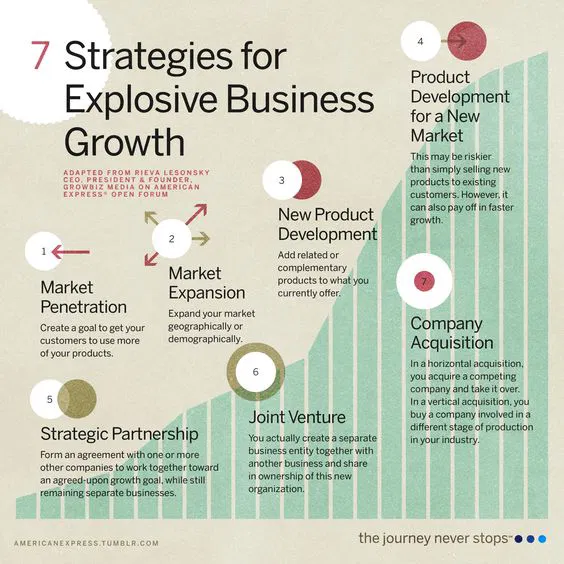In today’s hyper-competitive market, achieving explosive business growth demands more than incremental improvements—it requires bold, strategic moves.
Whether you’re a startup or an established enterprise, leveraging the right growth strategies can catapult your revenue, market share, and brand influence.
1. Product Development: Innovate or Stagnate
Strategy: Expand your offerings by adding complementary or related products to your existing portfolio.
Why It Works: Diversifying your product line increases customer lifetime value (CLV) and reduces dependency on a single revenue stream.
Examples & Tactics:
- Apple’s Ecosystem: By integrating iPhones with AirPods, Apple Watches, and services like Apple Music, Apple boosted cross-selling opportunities (Harvard Business Review).
- Nike’s Digital Shift: The Nike Training Club app complements its apparel, creating a seamless fitness ecosystem (Forbes).
Action Steps:
- Conduct market research to identify gaps.
- Use customer feedback to design complementary products.
- Launch beta versions to test demand.
2. Market Expansion: Go Global or Go Niche
Strategy: Grow geographically or demographically by entering untapped markets.
Why It Works: Expanding your reach mitigates regional risks and unlocks new customer segments.
Case Studies:
- Netflix’s Global Domination: By localizing content in 190+ countries, Netflix added 37 million subscribers in 2021 alone (Statista).
- Coca-Cola in Africa: Targeting Africa’s youthful demographic fueled a 9% revenue surge (Bloomberg).
Tactics for Success:
- Partner with local distributors to navigate cultural nuances.
- Use SEO tools like Google Keyword Planner to identify regional demand.
3. Customer Acquisition: Sell More to Existing Buyers
Strategy: Encourage existing customers to purchase more through upselling, cross-selling, or loyalty programs.
Why It Works: Acquiring a new customer costs 5x more than retaining an existing one (Invesp).
Examples:
- Amazon Prime: Members spend 2-3x more than non-members by leveraging free shipping and Prime Video (Business Insider).
- Starbucks Rewards: Personalized offers drive 40% of U.S. sales (CNBC).
Tools to Implement:
- CRM platforms like Salesforce for targeted campaigns.
- AI-driven recommendation engines.
4. Horizontal Acquisition: Dominate Your Competitors
Strategy: Acquire a direct competitor to consolidate market share.
Why It Works: Eliminating competition instantly boosts your customer base and reduces price wars.
Case Study:
- Facebook’s Instagram Buy: Acquiring Instagram for $1 billion in 2012 neutralized a rival and captured younger audiences (The Verge).
Steps to Execute:
- Identify competitors with overlapping audiences.
- Conduct due diligence to assess cultural fit.
5. Vertical Acquisition: Control Your Supply Chain
Strategy: Acquire companies upstream (suppliers) or downstream (distributors) in your value chain.
Why It Works: Vertical integration reduces costs and ensures quality control.
Examples:
- Disney-Pixar Merger: Owning Pixar’s animation tech streamlined Disney’s content production (WSJ).
- Tesla’s Battery Factories: Gigafactories cut battery costs by 56% (Reuters).
Key Considerations:
- Assess long-term operational synergies.
- Use tools like Porter’s Value Chain Analysis.
6. Joint Ventures: Share Risks, Multiply Rewards
Strategy: Co-create a new entity with another company to pursue shared goals.
Why It Works: Joint ventures pool resources and expertise while mitigating individual risks.
Case Study:
- Sony-Ericsson Partnership: Combined Sony’s tech with Ericsson’s telecom expertise to dominate early mobile markets (Financial Times).
Best Practices:
- Draft clear agreements on profit-sharing and exit clauses.
- Use project management tools like Asana for collaboration.
7. Strategic Partnerships: Collaborate to Innovate
Strategy: Form alliances with non-competing brands to co-market or co-develop products.
Why It Works: Partnerships amplify reach and credibility through combined audiences.
Examples:
- Spotify-Starbucks: Playlist integration in Starbucks stores boosted user engagement by 20% (AdWeek).
- Google-NASA Quantum AI Lab: Accelerated AI breakthroughs through shared R&D (NASA).
Implementation Tips:
- Align with brands that share your values.
- Track ROI using analytics platforms like Google Analytics.
Conclusion: Fuel Your Growth Engine
Explosive growth isn’t accidental—it’s engineered through strategic choices. Whether through acquisitions, partnerships, or product innovation, each strategy offers unique advantages.
Start with one tactic, measure results using KPIs, and scale iteratively. For tailored guidance, explore tools like SEMrush for SEO optimization or McKinsey’s Growth Framework for strategic planning.
The journey never stops—neither should your growth.
The image belongs to Rieva Lesonsky


